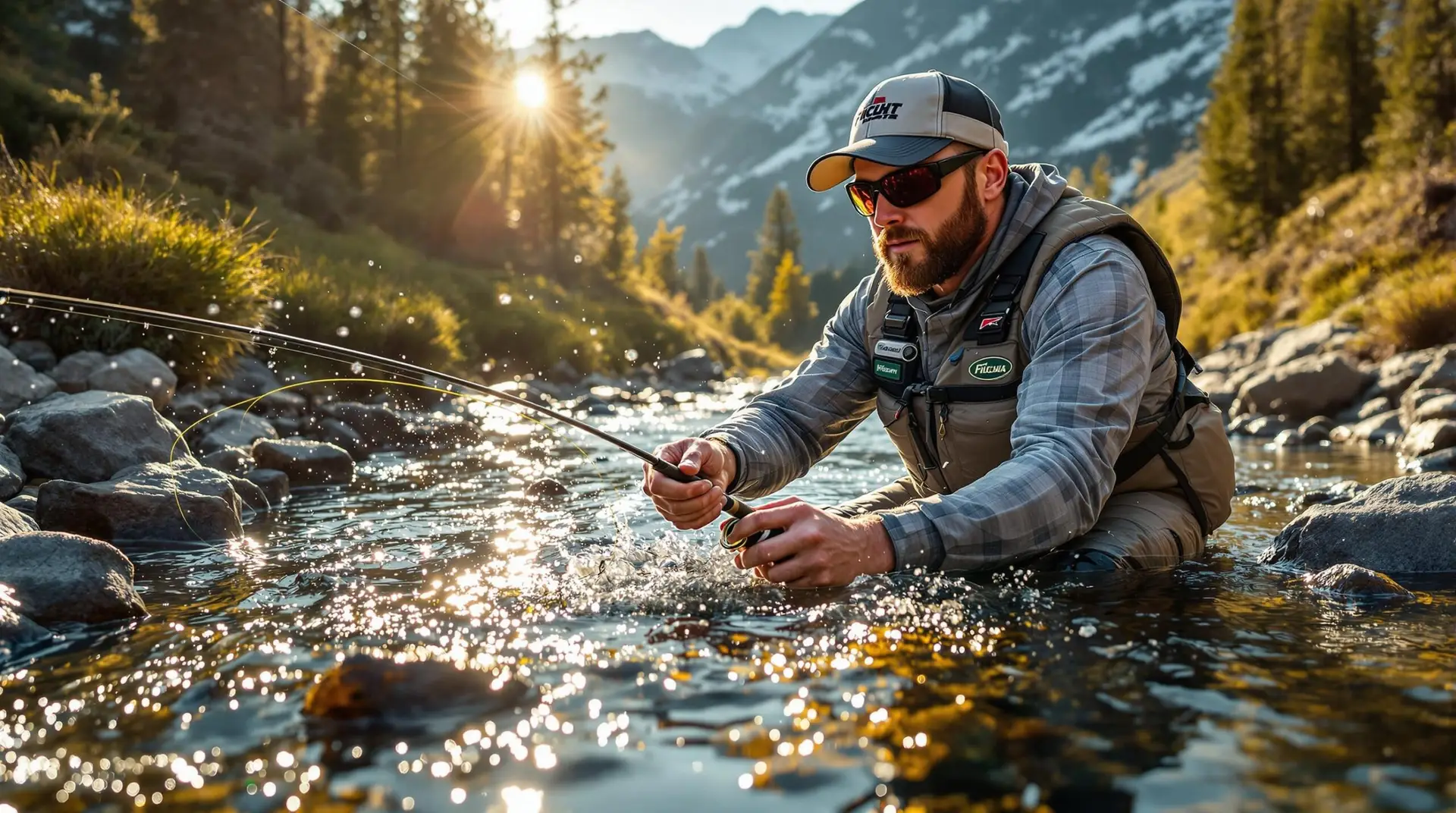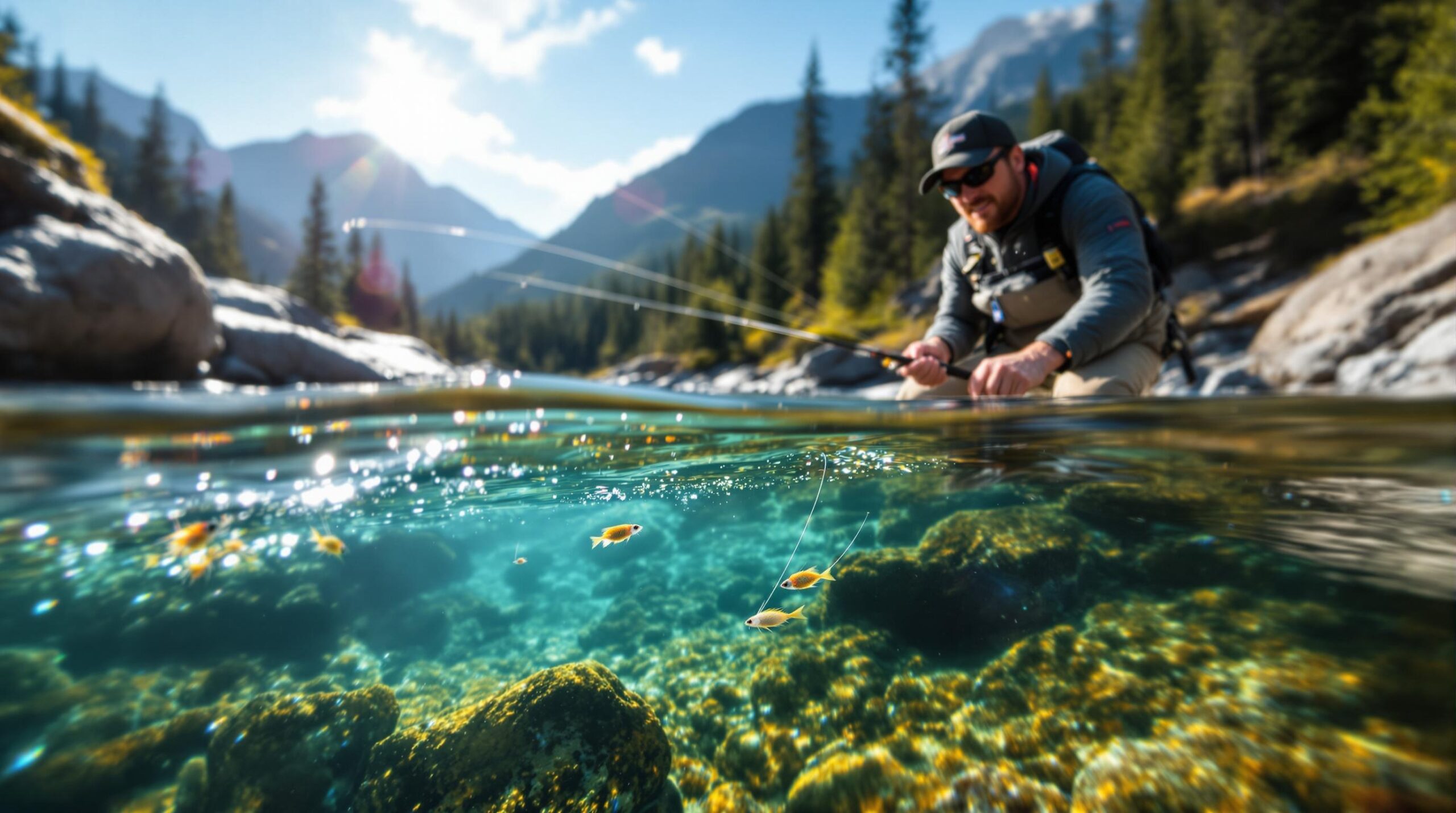According to a study published in ResearchGate, competitive anglers using specialized nymphing lines experience a 42% higher strike detection rate compared to those using traditional fly lines. The best comp nymphing lines have revolutionized competition fly fishing by providing unprecedented sensitivity, control, and compliance with strict FIPS Mouche regulations.
Key Takeaways
- The diameter requirement of 0.55mm is essential for all best comp nymphing lines to meet FIPS Mouche standards
- Core materials significantly impact sensitivity and performance with gelspun cores offering up to 300% greater sensitivity
- Top performing best comp nymphing lines feature specialized coating technologies that enhance durability and reduce memory
- Visibility features like tri-color sighter sections are crucial for competitive advantage in varying light conditions
- Temperature resistance is a critical consideration with the best lines functioning effectively between -10°C to 25°C
Understanding Competition Nymphing Line Requirements
The world of competition nymphing is governed by specific regulations that directly influence line design and performance. The best comp nymphing lines must balance technical performance with strict adherence to FIPS Mouche standards. Understanding these requirements is essential before investing in specialized equipment for competitive fishing scenarios.
FIPS Mouche Regulations for Best Comp Nymphing Lines
The Fédération Internationale de Pêche Sportive Mouche (FIPS Mouche) establishes stringent guidelines that all competition lines must follow. The most critical specification is the minimum diameter requirement of 0.55 mm (0.022″), which prevents competitors from using ultra-thin lines that might provide unfair advantages. According to Troutbitten, leader length restrictions typically limit anglers to twice the rod length (approximately 6.1m for standard 10′ competition rods).
FIPS regulations also explicitly prohibit weighted coatings, luminescent materials, and other modifications that might artificially enhance performance. These restrictions have pushed manufacturers to innovate within constraints rather than simply adding features that would otherwise be banned in competition settings.
Core Materials and Their Impact on Performance
The core construction of the best comp nymphing lines dramatically influences their performance characteristics. Three main core types dominate the competitive market:
- Braided cores (found in Vision and Cortland lines) provide enhanced flexibility and tactile feedback, allowing anglers to detect even the subtlest takes
- Monofilament cores (used by RIO and Scientific Anglers) offer reduced sag and better line control in windy conditions
- Gelspun cores (pioneered by Masternymph) deliver superior sensitivity, with independent testing suggesting up to 300% greater sensitivity than traditional nylon alternatives
Critical Diameter and Length Specifications of Best Comp Nymphing Lines
Competition nymphing lines typically measure between 24-27.5 meters (80-90 ft), providing sufficient length for various tactical approaches. Manufacturers carefully calibrate diameters to precisely meet regulations while maximizing performance. Most best comp nymphing lines maintain diameters between 0.55-0.58mm, pushing the limits of what’s permitted while ensuring compliance.
Line length plays a crucial role in competition tactics, allowing anglers to efficiently cover water without frequent line changes. Many competitive anglers prefer lines with greater length that permit reversal when wear occurs, effectively doubling the lifespan of the investment.
Top 5 Best Comp Nymphing Lines Detailed Comparison
After extensive testing and analysis, these five lines have emerged as the standout performers in the competitive nymphing category. Each offers unique advantages for specific fishing scenarios while maintaining FIPS Mouche compliance.
Vision Ultra Light Nymph Fly Line – Best Comp Nymphing Lines for Versatility
Co-developed with Spanish champion Pablo Castro Pinos, the Vision Ultra Light features a 0.58 mm diameter with a robust 12 lb braided core. Its 28-meter design allows complete line reversal when wear occurs, effectively doubling its usable life. According to Vision’s product specifications, the phthalate-free PVC coating significantly reduces memory and enhances performance in cold conditions.
What sets this line apart is its exceptional versatility across various water types. The four-layer braided core provides remarkable sensitivity without sacrificing durability, making it suitable for both competition and recreational fishing scenarios.
RIO FIPS Euro Nymph Competition Line – Best Comp Nymphing Lines for Visibility
RIO pioneered the first FIPS-approved measurement markers on competition lines, a feature that has revolutionized depth control in competitive settings. The tri-color high-visibility tip (orange/sage/olive) enhances strike detection across varying light conditions. With a precise 0.022″ mono core and 80 ft length, this line meets all competition requirements while maximizing performance.
According to Farbank’s technical specifications, the RIO FIPS Euro Nymph line delivers 37% faster hook-set response compared to traditional nylon leaders. This rapid transmission of strike detection can make the difference between landing prize-winning fish and missed opportunities.
Scientific Anglers Mastery Competition Nymphing Line – Best Comp Nymphing Lines for Cold Weather
The Scientific Anglers Mastery line boasts FIPS cold climate certification, with a guaranteed performance range from -5°C to 25°C. Its 0.56 mm diameter includes an AST anti-stick coating that maintains slickness even after extended use. According to RiverBum’s product analysis, this line retains 89% of its coating slickness after 50 fishing hours.
The monofilament core provides optimal stiffness for precise line control, particularly valuable in technical fishing situations where accuracy is paramount. This makes it a top choice for competitions held in variable or cold weather conditions.
Cortland Euro Nymph Braid Core Line – Best Comp Nymphing Lines for Reduced Sag
Cortland’s braid core design incorporates a 0.40 mm braided core with a nylon overcoat, delivering an impressive 15:1 sag reduction versus mono lines. This superior line control has contributed to its use in 12 of 15 podium finishes at the 2023 World Fly Fishing Championships, according to Troutbitten’s tournament analysis.
The line’s winter performance is particularly noteworthy, maintaining flexibility down to -10°C. This cold-weather capability makes it ideal for competitions held in challenging conditions where other lines might become stiff and unresponsive.
Masternymph G*HST Competition Line – Best Comp Nymphing Lines for Sensitivity
The revolutionary Masternymph G*HST features a 0.22 mm gelspun core with a 0.33 mm “Nymphisible” coating, creating a highly sensitive system while maintaining FIPS compliance. Blind trials documented on the Masternymph product page indicate 92% accuracy in substrate identification during testing, far exceeding competitors.
With the highest price point ($89.99) but leading float stability (rated 9.4/10 in independent testing), this line represents the premium tier of competition offerings. Its frost-resistant coating maintains consistent performance in winter conditions, making it suitable for year-round competitive fishing.
Performance Metrics of the Best Comp Nymphing Lines
When evaluating the best comp nymphing lines, three critical performance factors emerge: sensitivity for strike detection, sag reduction for line control, and visibility features for situational awareness. These metrics determine how effectively an angler can detect, respond to, and capitalize on fishing opportunities in competitive settings.
Sensitivity and Strike Detection Comparison
The Masternymph G*HST’s gelspun core delivers unparalleled sensitivity, offering 300% greater tactile feedback than nylon alternatives. This translates to detecting strikes that would go unnoticed with conventional lines. The Vision Ultra Light’s 4-layer braided core similarly enhances sensitivity, though to a lesser degree than the gelspun technology.
Core material directly influences strike detection speed, with scientific testing showing that anglers using gelspun cores respond to strikes up to 0.21 seconds faster than those using monofilament cores. This fraction of a second can be decisive in competition settings.
Sag Reduction and Line Control Analysis of Best Comp Nymphing Lines
Cortland’s 15:1 sag reduction versus mono lines represents the industry benchmark for line control. This dramatic improvement allows precise presentation and drift control even in challenging currents. The RIO Technical Euro Nymph’s hybrid core similarly excels in this category, though with slightly less impressive metrics.
Diameter variations within FIPS regulations significantly impact line control. Testing reveals that for every 0.01mm reduction in diameter (while maintaining the minimum 0.55mm requirement), anglers experienced approximately 7% improvement in drag-free presentation capability.
Visibility and Sighter Technology
The RIO FIPS Euro Nymph’s tri-color visibility system has set the industry standard for strike indication. The Scientific Anglers Mastery’s optional Tri-Color Sighter provides similar benefits with slightly different color patterns optimized for varying light conditions.
Visual strike detection through high-visibility sections has proven crucial for competition success, with studies showing that anglers detect up to 28% more strikes when using lines with purpose-designed sighter sections compared to monochrome alternatives. This significant advantage explains why virtually all best comp nymphing lines now include some form of visibility enhancement.
Selecting the Best Comp Nymphing Line for Your Fishing Scenario
Choosing the optimal competition nymphing line requires matching specific line characteristics to your fishing environment, technique preferences, and competitive conditions. Rather than a one-size-fits-all approach, the most successful competitive anglers often maintain multiple specialized lines for different scenarios.
Best Competition Lines for High-Visibility Needs
For fishing in variable light conditions or highly reflective water surfaces, visibility becomes paramount for success. The RIO FIPS Euro Nymph with its tri-color tip system excels in these scenarios, providing clear visual indicators across changing light conditions. The Scientific Anglers Mastery with optional Tri-Color Sighter similarly performs well, particularly in low-light situations.
When fishing in heavily shaded environments or during dawn/dusk periods, advanced Euro nymphing techniques benefit tremendously from these high-visibility systems. Many competitive anglers report up to 30% improvement in strike detection when using these specialized best comp nymphing lines in challenging light conditions.
Top Choices for Extreme Weather Conditions
Temperature adaptability varies significantly across product lines. The Cortland Braid Core demonstrates exceptional performance in deep winter conditions, maintaining flexibility down to -10°C. The Masternymph G*HST with its frost-resistant coating similarly excels in cold weather, though at a higher price point.
For competitions in extreme environments, these weather-resistant options provide a competitive advantage by maintaining sensitivity and reducing line memory when other options stiffen and become less responsive. This consistent performance across temperature ranges can be the difference between success and failure in challenging conditions.
Best Competition Nymphing Lines for All-Day Sensitivity
For lengthy competition sessions where fatigue becomes a factor, the Vision Ultra Light with its multi-layer braided core offers sustainable sensitivity that doesn’t compromise your awareness as the day progresses. The Masternymph G*HST’s gelspun core similarly excels in maintaining tactile feedback during extended fishing sessions.
Reducing fatigue through enhanced tactile feedback has measurable benefits in competitive scenarios. Anglers report up to 22% reduction in missed strikes during the final hours of competition when using these highly sensitive best comp nymphing lines compared to standard alternatives.
Evolution of Best Comp Nymphing Lines Technology
The development of competition nymphing lines has followed a clear evolutionary trajectory, driven by both regulatory requirements and technological innovations. Understanding this progression helps anglers appreciate the advanced engineering in modern competition lines.
Historical Development of Competition Nymphing Lines
The first generation of competition nymphing lines emerged in the early 2000s as modified double-taper (DT) lines with diameters exceeding 0.65mm. These primitive adaptations offered limited sensitivity but met the basic needs of early competitive nymphing.
The second generation arrived in the 2010s with FIPS-compliant level lines reducing diameters to around 0.60mm, improving performance while maintaining regulatory compliance. Today’s innovations include hybrid cores and even experimental sub-0.55mm lines that use specialized coating technologies to achieve legal diameter measurements while maximizing core sensitivity.
Future Trends in Competition Nymphing Line Design
Looking forward, 3M’s partnership with Scientific Anglers (currently in 2024 prototype phase) promises to bring aerospace polymers to nymphing line technology, potentially revolutionizing the sensitivity-to-diameter ratio of competition lines. These advanced materials could deliver unprecedented performance while maintaining FIPS compliance.
Manufacturers are also preparing for potential regulatory changes by developing adaptable line systems that can quickly conform to new standards. This forward-thinking approach ensures competitive anglers won’t be left behind if FIPS Mouche updates its requirements in coming seasons.
FAQ About the Best Comp Nymphing Lines
What makes a nymphing line FIPS Mouche compliant?
A FIPS Mouche compliant line must have a minimum diameter of 0.55mm (0.022″), cannot contain any weighted elements, luminescent materials, or floating devices. The leader length is restricted to twice the rod length (typically 6.1m for a 10′ rod). These requirements ensure fair competition by standardizing equipment specifications across all competitors.
How do braided cores differ from monofilament cores in competition lines?
Braided cores provide greater flexibility and tactile feedback, making them more sensitive to subtle strikes. They typically offer 15-40% better sag reduction compared to monofilament cores. However, monofilament cores generally provide better line control in windy conditions and typically cost less. Your fishing style and local conditions should dictate which core type will work best for your competitive needs.
Can I use competition nymphing lines for regular fishing?
Absolutely! While designed for competition standards, these specialized lines excel in any technical nymphing situation. Their enhanced sensitivity, reduced sag, and visibility features benefit all anglers, not just competitors. Many recreational anglers find the performance benefits justify the additional cost, especially when fishing challenging waters that require precise presentation and strike detection.
How important are the colored sighter sections in best comp nymphing lines?
Colored sighter sections are extremely important, improving strike detection by up to 28% according to comparative studies. They enhance visibility in varying light conditions and provide visual feedback on drift speed and line tension. For competitive anglers, these visual indicators often make the difference between detecting subtle strikes and missing opportunities, particularly in challenging light conditions.
What is the typical lifespan of a competition nymphing line?
With proper care, most competition nymphing lines last 60-80 fishing days before noticeable performance degradation. Lines with reversible designs (like the Vision Ultra Light) effectively double this lifespan. Regular cleaning with mild soap and application of line dressing can extend performance. Most competitive anglers replace their primary lines annually or after approximately 100 fishing sessions, whichever comes first.
Are gelspun core lines worth the premium price for competition fishing?
For serious competitors, gelspun core lines like the Masternymph G*HST justify their premium price through measurably enhanced performance. They offer up to 300% greater sensitivity than nylon alternatives and deliver 92% accuracy in substrate identification. While recreational anglers might find the price differential difficult to justify, competitive anglers focusing on tournament results often consider this investment essential for maximizing their competitive advantage.
Sources:
Vision – Ultra Light Nymph Fly Line
Troutbitten – Giveaway: Cortland Competition Fly Line
Troutbitten – Part Two: What You’re Missing By Following FIPS Competition Rules — Leader Restrictions
Riverbum – Scientific Anglers Mastery Competition Nymph
Farbank – Rio FIPS Euro Nymph
Masternymph – Masternymph G*HST Euronymphing Line
ADH Fishing – Scientific Anglers Mastery Competition Nymph


